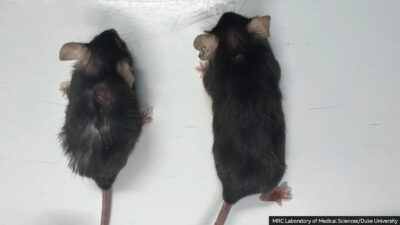Twenty people have been given the gift of sight thanks to an unlikely byproduct of the food industry: pig skin. A protein from the humble farm animal is proving surprisingly effective at correcting people’s vision. Researchers from Linköping University and LinkoCare Life Sciences AB created a special corneal implant made from medical-grade collagen from porcine skin, a purified food industry byproduct that’s used in FDA-approved medical devices for treating glaucoma.
The implant was given to 20 patients with diseased corneas, the outermost layer of the eye, including 14 blind individuals and six with partial blindness. The condition affects millions of people all over the world, and cornea transplants are the only curative treatment for corneal blindness. A 2016 study estimated that around 12.7 million people are currently on wait lists for the treatment, and only one in 70 receive the procedure.
The transplant requires a human donor, but many patients with diseased corneas live in developing countries in Asia and South America where access remains limited.
But pig skin is giving these individuals hope for the future.
The implant doesn’t require a human donor, just the skin of a pig.
According to a study recently published in Nature Biotechnology, the new procedure is much less invasive than a cornea transplant, which requires doctors to surgically replace a cornea and sew it into place. This increases the risk of graft rejection, healing complications, infections, astigmatism, and the need for long-term support.
But the new procedure simplifies the process. No grafting necessary. The doctors simply insert the implant into the patient’s existing cornea, which requires no stitching and is minimally invasive.
All 20 patients involved in the study saw their sight improve.
“The operations were free from complications; the tissue healed fast; and an eight-week treatment with immunosuppressive eye drops was enough to prevent rejection of the implant,” according to the study press release. “With conventional cornea transplants, medicine must be taken for several years. The patients were followed for two years, and no complications were noted during that time.”
The patients’ corneas were restored to normal, giving some individuals 20/20 vision. The procedure proved just as, if not more, effective than a traditional cornea transplant. It ended up working so well that the researchers were shocked at the results.
“We were surprised with the degree of vision improvement,” said Neil Lagali, a professor of experimental ophthalmology at Linköping University in Sweden who co-authored the study.
But some patient’s sight improved better than others. Twelve patients wound up with an average visual acuity of 20/58 with glasses; functional vision is defined as 20/40 or better with lenses, but it still marks a vast improvement.
“We insert our material into this pocket to thicken the cornea and to reshape it so that it can restore the cornea’s function,” Lagali said.
The scientists believe the new method could be used to improve eyesight around the world.
“Bioengineering implantable tissue is the key to addressing the global burden of corneal blindness,” the press release says.
And outside experts agree.
“The concept that we could have bioengineered corneas would be revolutionary,” said Dr. Marian Macsai, a clinical professor of ophthalmology at the University of Chicago who wasn’t involved in the study. “It would potentially eliminate the risk of rejection and potentially make corneas available to patients worldwide.”
The method comes with other benefits as well. The implants can be stored much longer than cornea implants, which must be used within two weeks. Meanwhile, the implants can last up to two years.
The implants come prepackaged and sterile, reducing the risk of infection and the need for pathogen testing.
The procedure still needs to go through clinical trials before it can be formally approved for healthcare settings. The scientists also want to see if the pig skin protein can be used to treat other types of eye diseases.
“We’ve made significant efforts to ensure that our invention will be widely available and affordable by all and not just by the wealthy,” Mehrdad Rafat, the researcher and entrepreneur behind the design and development of the implants, said in a press release. “That’s why this technology can be used in all parts of the world.”
















